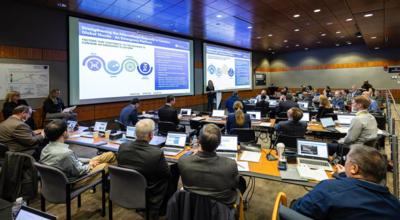Tue, Jun 25, 2024
5th Exercise Assesses Readiness Against Orbital Threats
NASA got the "planetary defense community" together for a good ol' game of '5th Planetary Defense Interagency Tabletop Exercise', playing out their responses to a prospective celestial impact.

IN reality the word "tabletop" belies a level of fun NASA folks probably did not have, but the exercise did let everyone game out exactly how their agencies would work together in case of asteroid impact. The exercise takes place on a biennial basis, bringing together the Planetary Defense Coordination Office, FEMA (Federal Emergency Management Agency) and the U.S. Department of State Office of Space Affairs as they assess how well the country would fare under threat of a potentially hazardous asteroid or comet. The administration stressed that there are currently "no known significant asteroid impact threats for the foreseeable future" but it never hurts to dust off the books and game it out. They didn't just try to plan for apocalyptic impacts, either, but smaller bodies that would cause minor regional damage with less forewarning.
The exercise considered the response to a novel asteroid given 72% chance of striking true in 14 years, with gamers having to deal with problems like assessments, studies, and trajectory planning as the hypothetical body passed behind the Sun. The exercise made use of fresh data from the recent DART mission, a test that bore out whether the world could snipe incoming space debris with suitably kinetic operations.

“The uncertainties in these initial conditions for the exercise allowed participants to consider a particularly challenging set of circumstances,” said Lindley Johnson, planetary defense officer emeritus NASA Headquarters in Washington. “A large asteroid impact is potentially the only natural disaster humanity has the technology to predict years in advance and take action to prevent.”
“Our mission is helping people before, during, and after disasters,” added Leviticus “L.A.” Lewis, FEMA detailee to NASA’s Planetary Defense Coordination Office. “We work across the country every day before disasters happen to help people and communities understand and prepare for possible risks. In the event of a potential asteroid impact, FEMA would be a leading player in interagency coordination.”
“These outcomes will help to shape future exercises and studies to ensure NASA and other government agencies continue improving planetary defense preparedness,” said Johnson.
More News
He Attempted To Restart The Engine Three Times. On The Third Restart Attempt, He Noticed That Flames Were Coming Out From The Right Wing Near The Fuel Cap Analysis: The pilot repor>[...]
Make Sure You NEVER Miss A New Story From Aero-News Network Do you ever feel like you never see posts from a certain person or page on Facebook or Instagram? Here’s how you c>[...]
From 2009 (YouTube Edition): Leading Air Show Performers Give Their Best Advice for Newcomers On December 6th through December 9th, the Paris Las Vegas Hotel hosted over 1,500 air >[...]
Aero Linx: NASA ASRS ASRS captures confidential reports, analyzes the resulting aviation safety data, and disseminates vital information to the aviation community. The ASRS is an i>[...]
“For our inaugural Pylon Racing Seminar in Roswell, we were thrilled to certify 60 pilots across our six closed-course pylon race classes. Not only did this year’s PRS >[...]
 NTSB Final Report: Rutan Long-EZ
NTSB Final Report: Rutan Long-EZ ANN FAQ: Turn On Post Notifications
ANN FAQ: Turn On Post Notifications Classic Aero-TV: ICAS Perspectives - Advice for New Air Show Performers
Classic Aero-TV: ICAS Perspectives - Advice for New Air Show Performers ANN's Daily Aero-Linx (06.28.25)
ANN's Daily Aero-Linx (06.28.25) Aero-News: Quote of the Day (06.28.25)
Aero-News: Quote of the Day (06.28.25)




